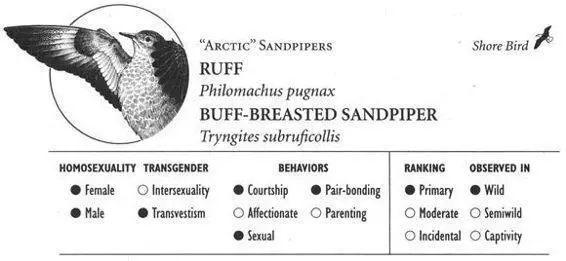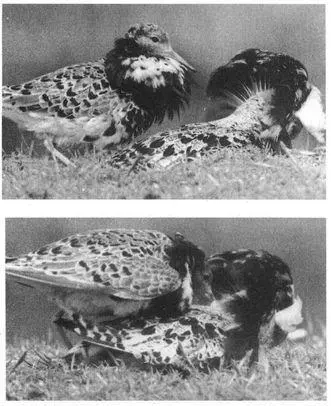*Stevens, E. F. (1996) Personal communication.
———(1991) “Flamingo Breeding: The Role of Group Displays.” Zoo Biology 10:53—63.
*Studer-Thiersch, A. (1975) “Basle Zoo.” In Kear and Duplaix-Hall, Flamingos, pp. 121—30.
Tourenq, C., A. R. Johnson, and A. Gallo (1995) “Adult Aggressiveness and Crèching Behavior in the Greater Flamingo, Phoenicopterus ruber roseus.” Colonial Waterbirds 18:216—21.
*Wilkinson, R. (1989) “Breeding and Management of Flamingos at Chester Zoo.” Avicultural Magazine 95:51-61.
SANDPIPERS AND THEIR RELATIVES

RUFF
IDENTIFICATION: A large (12 inch) sandpiper with gray or brownish plumage and, in some males, spectacular ruffs and feather tufts on the head that vary widely in color and pattern (see below). DISTRIBUTION: Northern Europe and Asia; winters in Mediterranean, sub-Saharan Africa, Middle East, India. HABITAT: Tundra, lakes, swampy meadows, farms, floodlands. STUDY AREAS: Texel, Schiermonnikoog, Roderwolde, and several other locations in the Netherlands; Oie and Kirr Islands, Germany.
BUFF-BREASTED SANDPIPER
IDENTIFICATION: A medium-sized (7–8 inch) wading bird with a small head and short beak, buff-colored face and underparts, and regular dark brown patterning on the back and crown. DISTRIBUTION: Arctic Canada, Alaska, extreme northeast Siberia; winters in south-central South America. HABITAT: Tundra, grass-lands,mudflats. STUDY AREA: Meade River, Alaska.
Social Organization
Ruffs and Buff-breasted Sandpipers are both LEKKING species, which means that males gather together to perform elaborate courtship displays on communal grounds known as LEKS (some Buff-breasts also display solitarily). The mating system is polygamous or promiscuous: males (and sometimes females) mate with multiple partners, and females raise any resulting offspring on their own. Outside of the breeding season these sandpipers tend to associate in flocks, which can number in the thousands among Ruffs.
Description
Behavioral Expression: There are four distinct types or “classes” of male Ruffs, differing in their appearance, social behavior, and sexuality. RESIDENT males generally have dark plumage (with a wide variety of different feather patterns) and defend their own territories on the lek. MARGINAL males look similar to residents but do not have their own territories; they stay on the periphery of the lek and are often attacked by residents. SATELLITE males usually have white or light-colored plumage; they do not own territories, but often visit the lek and associate with particular residents. Finally, NAKED-NAPE males lack the nuptial plumage—ruff and head tufts—of other males, giving them the superficial appearance of females. They are not territorial either, but occasionally visit leks for short periods. Naked-napes may include younger males and/or adults passing through on their migratory journeys prior to developing their breeding plumage. Resident and satellite males also differ genetically from one another.
Homosexual behavior occurs among males of all types and is especially prominent between residents and satellites. While a resident male is displaying on his territory, one or more satellites may approach him and engage in courtship behaviors. Most notable of these is SQUATTING, in which the males lie with their bellies to the ground and expand their ruffs, crouching together while the resident places his bill on top of the satellite’s head. This may lead to homosexual copulation, in which either the resident or the satellite mounts the other male and attempts to make genital contact—he lowers himself and spreads his wings while holding the other male’s head feathers in his bill. The mounted bird reacts by either remaining crouched or by trying to shake the other male off his back. If more than one satellite male is present on the lek, they sometimes also mount each other. Many satellites have “preferred” resident males with whom they spend most of their time, and residents may also actively entice satellite males onto their display courts.
Females are often drawn to the activities between resident and satellite males, and heterosexual courtship and copulation (involving either residents or satellites) may occur at the same time as homosexual activities (or shortly thereafter). Occasionally, a satellite male will mount a resident male who is in the act of mating with a female; residents and satellites may also try to prevent each other from mating with females. Naked-nape males also engage in homosexual mounting with each other and with residents. When a naked-nape arrives on the lek, the resident male may respond by squatting; the naked-nape approaches him in a horizontal posture or may himself squat. The naked-nape may then try to mount the resident, although he does not usually lower his body to “complete” the copulation; he may also mount in a backwards position with his head facing the resident’s tail. Residents also sometimes mount naked-napes, and naked-napes also mount each other. Naked-nape males are sometimes courted by other males during stopovers on the spring migration as well (i.e., outside of the mating season). Although marginal males rarely participate in sexual activity (with either males or females), they have occasionally been seen mounting other males.
A “marginal” male Ruff approaches a crouching “satellite” male (above) and then mounts him

Female Ruffs—also known as Reeves—engage in homosexual behavior as well. They often arrive on a lek in groups, and females sometimes mount one another as they begin simultaneously crouching near a resident male during courtship activities. Genital contact may occur, although this is difficult to verify, even for heterosexual (or male homosexual) copulations. Females also occasionally court each other, using some of the same stylized movements such as wing quivering that are seen in heterosexual courtship.
Male Buff-breasted Sandpipers attract other birds to their lek territories with a dramatic WING-UP DISPLAY that can be seen from miles away, in which they raise one wing vertically and flash its brilliant satiny-white underlining. Usually females are attracted to this courtship display, and sometimes up to six of them gather around a displaying male. Often, however, a male from a neighboring territory is drawn to the display as well (or he may “camouflage” himself in a group of females). He may interrupt the courtship when he arrives by mounting the displaying male and trying to copulate with him. He may also aggressively peck the other male on his head and neck while mounted on him, then fly back to his own territory. Sometimes the females follow him, and then the pattern of interruption and mounting is repeated, only this time the other male arrives to disrupt the courtship. This sequence of heterosexual courtship and homosexual mounting may be repeated many times, back and forth for an hour or more. Sometimes, instead of flying back to his own territory with the females, a male simply returns repeatedly to his neighbor’s territory, continuously interrupting the male’s courtship by mounting him. Homosexual mounting also occurs in other contexts: when not as many females are present on the leks (especially later in the mating season), one or more males may enter a neighbor’s territory and simply mount him. As many as four males at a time may participate in such activity.
Читать дальше














